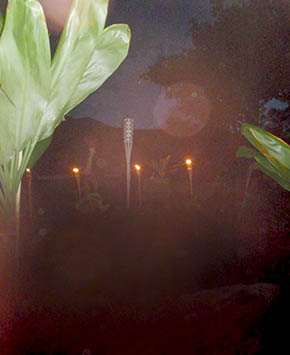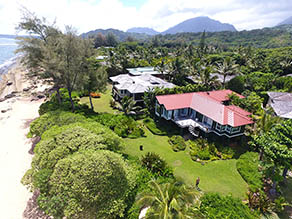 |
 |
 |
|||||
|
Naue Burials: 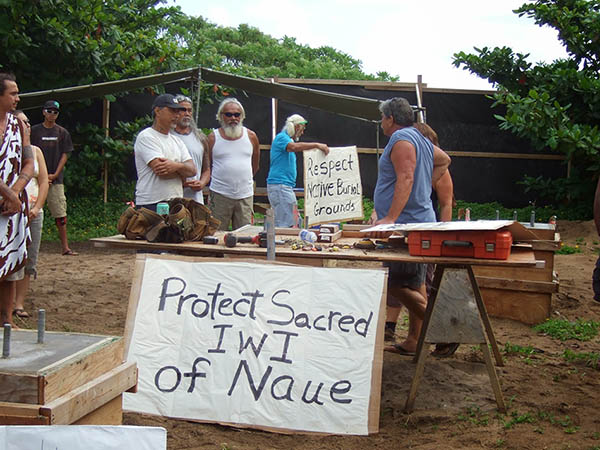
|
“Back in 2006, I became aware of the whole bones issue,” Ka‘iulani begins. “This kid called me and he said, ‘Auntie, I’ve been working on this job site in Kapa‘a Town, building a restaurant, and we found a jaw bone and I put it in my car. And ever since I’ve had this bone in my car, I broke my leg, my girlfriend broke both her wrist and her ankle.’ He said that his stereo of his car broke, the battery died, he was getting evicted from his house. He listed this whole bunch of stuff that had occurred after he put those bones in his car and he related all this bad luck to having that jaw bone in his car. 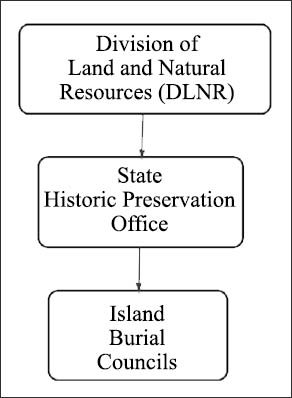
“We know, as Hawaiians, that when you’re dead it doesn’t really mean you’re not here, it just means you’re in a different realm and that the bones still have that mana attached to them. So you really don’t want to handle bones unless you know what you’re doing, and I came to learn about this much later. So I told this kid, ‘Well there’s got to be an archeologist.' "So I called the State archeologist. Little did I know that the State archeologist actually was just really in place to provide developers a way around the existing laws regarding finding bones. So I came to find out was that routinely here in Hawai‘i, the archeologists would come, they’d dig up the bones, they’d put them in bags or whatever, and remove them to either be put in hole somewhere, or stuck in a cellar, or a basement of some museum. “And so I came to be aware of what the actual process was: that what at the time the State Historic Preservation Department did, and what the archeologist did, was in concert with the burial councils to provide a way to nicely dig up those bones, dig a nice hole for them, chant a few prayers over them, and maybe throw some water in a bowl and some ti leaf and sprinkle it. And then you could just dig up the bones wherever you were and put them in this hole. It was just really all very down pat. “I unknowingly turned over this jaw bone to the State archeologist and I never, ever found out what became of that person. Because all the bones were divided up amongst the family, and sometimes maybe only one bone from that person got planted into the ground. Hawaiians believe that each bone that you find in the ground represents a whole person. So even though it was just a partial of a jaw, it was an entire human being for me, and also for this young man. He realized he was carrying somebody around in his car and that he’d better take care of it. “A little later on I was made aware of Nā Hala o Naue. This property, it was revealed to us, had fifty-five whole mummies of ali‘i women and children—they were actually mummified. And then lots what they called ‘scattered remains,’ which is single bones planted in the ground representing an entire person. The developer was absolutely determined to build. He even tried to rename the point from Nā Hala o Naue—which historically in ancient Hawai‘i was a hospital of sorts—to 'Brescia Point'! “When we occupied it, I sort of grabbed a tent, my cooler and my puppy and just threw it down and said, “I’m not leaving, I’m staying right here.” And we put torches in place on every burial that they had marked out. We planted tī leaf on every one. We provided a walkway so that people wouldn’t walk over the graves. This kind of captured the world’s imagination. Everybody came to visit. Everyone heard about the crazy lady living on the property next to Anthony Kiedes’s house, and they came out to see what was going on. 
"We had people from India come. My mentor Hank Fergerstrom told me that in order to get this thing moving forward, we had to incense the sensibilities of the community. We had to show how entirely outrageous and disgusting it is to build a vacation rental on a known graveyard. No matter who is in that realm. We would have fought just as hard had it been a Catholic graveyard. Anybody’s bones in the ground. I’m getting chicken skin thinking about that because there are other countries who routinely build on graveyards, no matter what type of person is in the round, no matter what the religion is. Here, so far, just the Hawaiians. “We made the BBC News, TMZ interviewed us, we had film crews come in, we were on Hawai‘i News Now. It was before Facebook. I always think ‘Dang, why didn’t we have Facebook?’ We had really like small-kine Internet at the time—Hotmail was big. And of course out in Hā‘ena, there is no reception. So it was all very rudimentary. But out of this came a huge thing where everyone was kind of going, ‘Okay wait a minute. When is enough, enough?’ All the people that built their houses on that coastline, they had maybe five or ten people in the ground, and certainly they felt horrible about doing it. I heard tell, from their mouths, but they still did it. 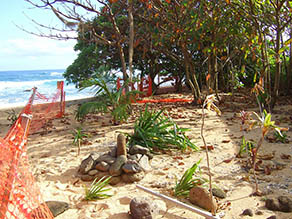
“I went to the Kaua‘i Historical Society and did a lot of reading, a lot of research. A lot of things were revealed to me about my own family bloodline. Because a lot of people said initially ‘What the heck is she doing out there? Who is she? We don’t even know who she is.’ "I grew up in Hanalei but my grandmother grew up in an orphanage, so I didn’t know who my family was. That was quite common for people to have children removed from the house, taken to the orphanage to be colonized. My grandmother was told her mother hated her, and Hawaiians were Americans, and she was completely colonized by the time I was born and didn’t talk about being Hawaiian. She just acted it out, which is a whole other subject. So there was nothing ever said, which is probably why I have such a big mouth now, because all my ancestors are going, ‘Tell it girl, tell it!’ “So we went out there, we threw our tents down, family members came and we were there for almost two years. In the beginning of it, I was trying to figure out, ‘Okay, how do we keep them from building?’ and I met a woman named Paulette Kaleikini. She is the woman who was responsible for halting the rail for so long. And what she did was amazing to me, so I flew to O‘ahu to meet with her. "Everyone thought that this multi-billionaire guy couldn’t get his house built because there was this crazy lady living on the property. No. I learned a long time ago that when you want to hurt rich people, you have to freeze their assets. So when I went to meet Paulette, she talked to me about a finance lien and explained to me what that was. 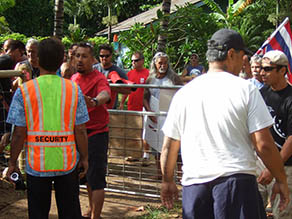
“A finance lien is when you challenge someone’s title and you attach a dollar amount to it, whatever the property is worth. You challenge their title saying ‘Prove to me that you have clear title to this property, because I have clear title to this property.’ You have to challenge their title and say ‘I’m the rightful title holder of this property.’ So in researching my family bloodline, I discovered that I was an heir to that area of Wainiha in my bloodline, and so using the royal patent, which actually every single piece of property in Hawai‘i nei is still under, I challenged his title and I said to him, ‘Hey I know you have a good title, because how much you paid for this property, but I’m the heir to the property, so now you have to prove to me and to everyone else that you truly have clear title to this property.’ “It was very theatrical that day when I served his contractor a hundred-million-dollar finance lien. Every police officer on the island was there. SWAT team members, they had dogs, they had paddy wagons and Hanalei Fergestrom was there with me. He was the “talking chief,” and I’m sitting in my tent holding this document going, ‘Once you do this young lady, you are opening the door, and the hounds of hell are going to come after you now.’ So I came out and the Chief of Police was there. I served him his copy, I served the contractor his copy and then the project manager his copy. I didn’t say a word, just said, ‘You’ve been served,’ and from then everything froze. The police decided to leave, and they left me there and it went on for about a year and a half, where they could not get rid of me because of that little old finance lien that was pending. It froze his assets. 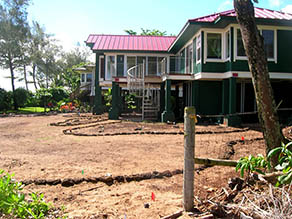
“Meantime I had this San Francisco Agency that does non-violent, passive protests. They were in front of his office in Alameda, California every day, holding signs that he is desecrating burial grounds in Hawai‘i. I had this big website up with his picture, ‘Tell Joe no!’ We did what we could on the Internet at the time. “At this point I have men in black following me around, because the guy is richer than God, and I’m staying out on this property, camping in a tent. I went home and showered some times and had to go to work and take care of my son, but for the most part I was out there. And this guy could not shake me loose until we finally got to court. “How he did it was, he sued me and one -to two- hundred John and Jane Doe’s. That is heavy psychological warfare. Anyone in a picture with me, anyone associated with me, anyone who burps the word ‘Naue’ was now all of a sudden on this multi-million-dollar law suit, in danger of losing their houses. He went after everyone, both guns out and blaring, and in the meantime I sat there and for me, ‘I’m a Hawaiian, I got nothing to lose by sticking up and sticking to my guns here because I got nothing he can take from me. I don’t own property, I have any money. I don’t care, I don’t care what he says, I’m not going to settle with him, I’m not going to stop talking about this.’ “I sat next to him at the burial council meeting and I said, ‘If you do this, you will die without a shirt on your back. I can promise you, you will die without a shirt on your back.’ I don’t know how good his life is right now, but I understand he’s encountered many misfortunes since 2008 when I was evicted and they poured the cement on the ‘iwi kūpuna so they could put their septic system on top of them. “After sixteen burial treatment plans, our then State of Hawai‘i Historic Preservation Division stepped in. That office is now gone, they disbanded it for—I think they called it——mismanagement. They over-ruled our Burial council’s sixteen denials of the burial treatment plans that this guy had been submitting. They overturned the sixteenth denial of the Burial Council and signed off on his permits. He did it. Well, actually he never proved his clear title. Judge Kathleen Watanabe never even looked into the issue and threw my finance lien out of court. “And so the house was built. I think he sold it for somewhere around seven million dollars very recently. I understand it was renting out between $10,000-$30,000 a week, depending on the season. What’s funny about that is he went into our newspaper and was quoted as saying ‘I’m just trying to build a single family home for me and my family.’ He got his way, as all the developers do, and the burial desecrations continue. 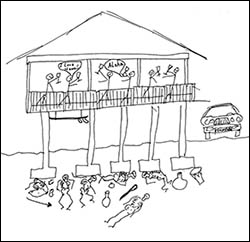
“I get messages, I get picture sent to me, it’s overwhelming really how often it actually happens and it’s kind of taken a backburner in my life. After a while you keep going to the illegal government, and you keep trying to get them to do the right thing and here’s what I learned: they’re not going to do the right thing. They’re interested in dollars and cents, and going to them to do the right thing—going to the illegal State of Hawai‘I—it was like going to the hardware store for bread. They don’t have it! "You've got to crunch the numbers and show them how it’s going to be really expensive for them to continue doing what they are doing. And Hank is the king of that. He will have protests and he’ll be talking to the cops and he’ll be like, ‘How long do I have stand right here, so that you can buy your wives a diamond tennis bracelet for Christmas? How many hours?’ That’s our game at this point. Costing the State of Hawai‘i money because we can’t stop them. “I was arrested in 2011 for the same thing, for blocking burial desecration. I put my body between the earth and the backhoe. I was dragged off by the cops and went through two years of legal battles until I was found guilty of obstruction of a government operation—the State of Hawai‘i digging up graves again for a septic system. And so my game became, ‘How can I just cost them a lot of money, how can I have some fun with this?’ Because going to court is no fun and at risk was me doing a year in prison at that point. So I got ten continuances before I made a pleading, I had three judges recused, and at the end of the game I cost the state of Hawaii about $379,000 for them to find me guilty of obstruction and fine me $250. They got that guilty conviction, but my mentors were like ‘You go girl! You spent plenty money!’” |
|
|||||
|
|||||
|
|||||
